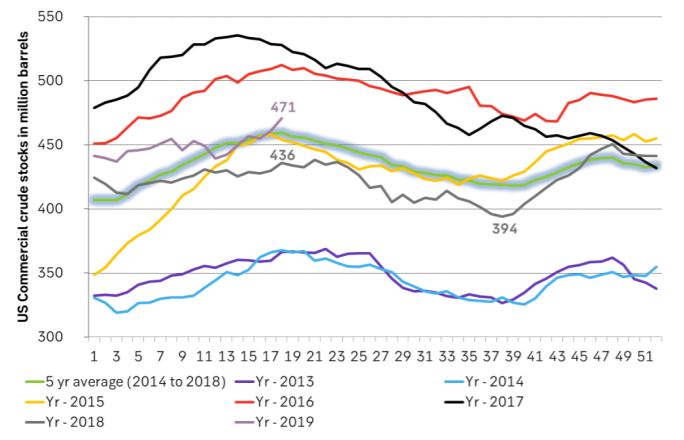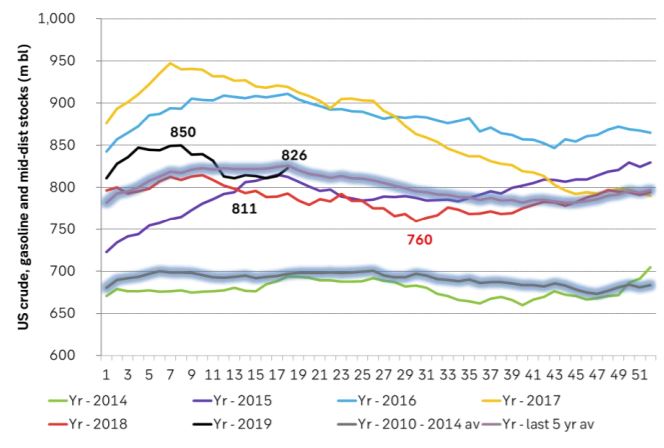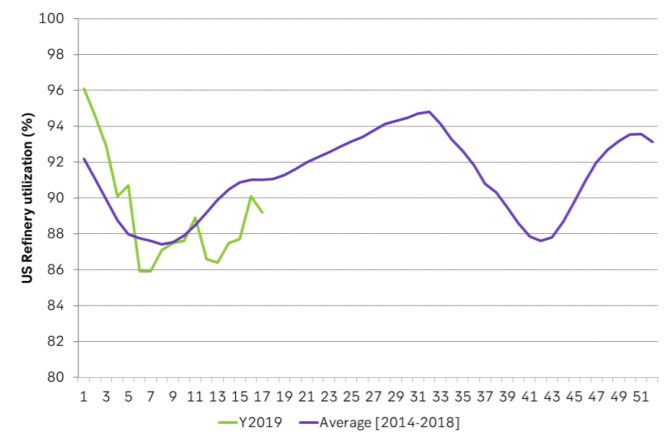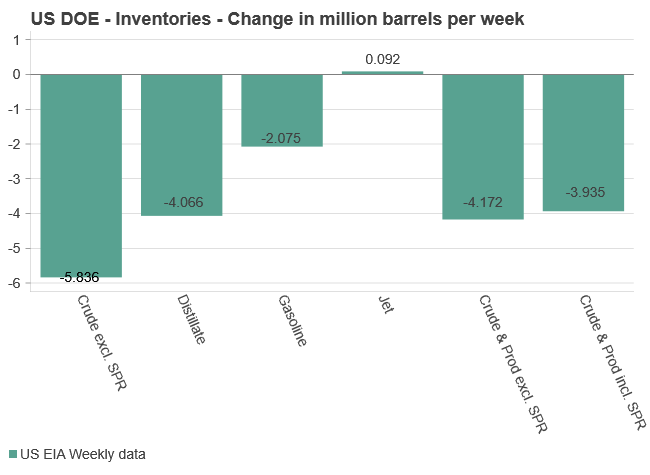Analys
A man with a moustache is pushing Iran into the corner


Donald Trump’s threat to add 25% tariffs on all Chinese imports is this morning sending Shanghai equities down 6%, S&P 500 futures down 1.7% and Brent crude down 2.1% to $69.4/bl. Over the past year oil and equities have followed each other more or less hand in hand. Brent crude has however traded down close to 9% since its peak on 25 April while the S&P 500 has ticked higher to new all-time highs.

A 31 m bl crude inventory increase in the US since 18 March versus a 5 year normal increase of 15.4 m bl has taken its toll on both WTI and Brent crude. This above normal increase is however easily explained by a 2.2% below normal (5yr average) US refinery utilization rate over the past 7 weeks (since 18 March). This has led to 20 m bl reduced refinery crude processing over those 7 weeks. US crude inventories are actually less above the 5 year average now than they were at the start of the year: 11 m bl now vs 35 m bl above 5yr at the start of the year. US crude, gasoline and mid-dist stocks are right at the 5yr average.
The oil market did get a kick up to $75.6/bl when Donald Trump’s “zero waivers” was announced. Rising US crude stocks (easily explained) has however taken some of the air out of crude prices sending them lower with market placing little concern on Iran and Venezuela with respect to added price.
Oil is selling down this morning with some good reason due to the risk of an escalating trade war between the US and China, but the rise in US crude stocks we have seen since mid-March is not a good reason. This will be reversed as US refineries eventually shifts from below normal utilization to instead above normal utilization.
Now John Bolton (US security advisor) is adding battleship diplomacy to the equation: First maximum financial pressure and distress towards Iran and then he push a gun into their face. The US is now sending the USS Abraham Lincoln carrier strike group to the Gulf. It does however look like this was decided for quite some time ago and that it had the Gulf as a destination on April 1 when it left Virginia in the US. It looks like the presence of aircraft carrier in the US is more about restoring US military presence to normal levels rather than an escalation.
What is rare is however that US security advisor John Bolton is communicating this instead of the Pentagon. He is delivering this as a political decision and move directly linked to US policy linked to Iran and that it is a response to escalating risks in Iran.
John Bolton is a long time Iran hawk and has earlier stated (before White House position) that the only way to stop Iran getting a nuclear weapon is by bombing Iran.
It does look like John Bolton has the initiative with respect to the US policy towards Iran. The positioning of USS Abraham Lincoln in the Gulf may not be a pure military escalation but the message from John Bolton accompanied by it is very uncomfortable.
If this was all about getting pressuring Iran for necessary concessions on the nuclear issues this would not be so bad. Demands from the US on this issue is however not very visible. What are the demands towards Iran on the nuclear issue? European countries have asked for clarity on this issue earlier on in total confusion of what the US is really demanding.
The real uncomfortable sense here is that John Bolton is not after an Iranian nuclear concession but is instead after a regime change. The booming US crude and liquids production has placed the US in a much stronger position to be hard handed towards its political adversaries in for example the Middle East.
A man with a moustache is placing a gun directly into the face of Iran while financially pushing the regime into the corner and the oil market participants should be concerned. Add a price premium. But how much is hard to quantify before it really happens.
Ch1: US crude stocks are up 31 m bl since 18 March vs 5yr normal increase of 15.4 m bl. US crude stocks are now however less above the 5yr normal than they were at the start of the year.

Ch2: US crude, gasoline and middle distillate stocks are slightly higher since its low of 811 m bl but it is at the 5yr average

Ch3: US refinery utilization since 18 March was 2.2% below the 5yr normal. That equates to some 20 m bl less crude processing and is a good explanation for why US crude stocks have risen some 16 m bl more than normal over that period.

Analys
Tightening fundamentals – bullish inventories from DOE

The latest weekly report from the US DOE showed a substantial drawdown across key petroleum categories, adding more upside potential to the fundamental picture.

Commercial crude inventories (excl. SPR) fell by 5.8 million barrels, bringing total inventories down to 415.1 million barrels. Now sitting 11% below the five-year seasonal norm and placed in the lowest 2015-2022 range (see picture below).
Product inventories also tightened further last week. Gasoline inventories declined by 2.1 million barrels, with reductions seen in both finished gasoline and blending components. Current gasoline levels are about 3% below the five-year average for this time of year.
Among products, the most notable move came in diesel, where inventories dropped by almost 4.1 million barrels, deepening the deficit to around 20% below seasonal norms – continuing to underscore the persistent supply tightness in diesel markets.
The only area of inventory growth was in propane/propylene, which posted a significant 5.1-million-barrel build and now stands 9% above the five-year average.
Total commercial petroleum inventories (crude plus refined products) declined by 4.2 million barrels on the week, reinforcing the overall tightening of US crude and products.


Analys
Bombs to ”ceasefire” in hours – Brent below $70

A classic case of “buy the rumor, sell the news” played out in oil markets, as Brent crude has dropped sharply – down nearly USD 10 per barrel since yesterday evening – following Iran’s retaliatory strike on a U.S. air base in Qatar. The immediate reaction was: “That was it?” The strike followed a carefully calibrated, non-escalatory playbook, avoiding direct threats to energy infrastructure or disruption of shipping through the Strait of Hormuz – thus calming worst-case fears.

After Monday morning’s sharp spike to USD 81.4 per barrel, triggered by the U.S. bombing of Iranian nuclear facilities, oil prices drifted sideways in anticipation of a potential Iranian response. That response came with advance warning and caused limited physical damage. Early this morning, both the U.S. President and Iranian state media announced a ceasefire, effectively placing a lid on the immediate conflict risk – at least for now.
As a result, Brent crude has now fallen by a total of USD 12 from Monday’s peak, currently trading around USD 69 per barrel.
Looking beyond geopolitics, the market will now shift its focus to the upcoming OPEC+ meeting in early July. Saudi Arabia’s decision to increase output earlier this year – despite falling prices – has drawn renewed attention considering recent developments. Some suggest this was a response to U.S. pressure to offset potential Iranian supply losses.
However, consensus is that the move was driven more by internal OPEC+ dynamics. After years of curbing production to support prices, Riyadh had grown frustrated with quota-busting by several members (notably Kazakhstan). With Saudi Arabia cutting up to 2 million barrels per day – roughly 2% of global supply – returns were diminishing, and the risk of losing market share was rising. The production increase is widely seen as an effort to reassert leadership and restore discipline within the group.
That said, the FT recently stated that, the Saudis remain wary of past missteps. In 2018, Riyadh ramped up output at Trump’s request ahead of Iran sanctions, only to see prices collapse when the U.S. granted broad waivers – triggering oversupply. Officials have reportedly made it clear they don’t intend to repeat that mistake.
The recent visit by President Trump to Saudi Arabia, which included agreements on AI, defense, and nuclear cooperation, suggests a broader strategic alignment. This has fueled speculation about a quiet “pump-for-politics” deal behind recent production moves.
Looking ahead, oil prices have now retraced the entire rally sparked by the June 13 Israel–Iran escalation. This retreat provides more political and policy space for both the U.S. and Saudi Arabia. Specifically, it makes it easier for Riyadh to scale back its three recent production hikes of 411,000 barrels each, potentially returning to more moderate increases of 137,000 barrels for August and September.
In short: with no major loss of Iranian supply to the market, OPEC+ – led by Saudi Arabia – no longer needs to compensate for a disruption that hasn’t materialized, especially not to please the U.S. at the cost of its own market strategy. As the Saudis themselves have signaled, they are unlikely to repeat previous mistakes.
Conclusion: With Brent now in the high USD 60s, buying oil looks fundamentally justified. The geopolitical premium has deflated, but tensions between Israel and Iran remain unresolved – and the risk of missteps and renewed escalation still lingers. In fact, even this morning, reports have emerged of renewed missile fire despite the declared “truce.” The path forward may be calmer – but it is far from stable.
Analys
A muted price reaction. Market looks relaxed, but it is still on edge waiting for what Iran will do

Brent crossed the 80-line this morning but quickly fell back assigning limited probability for Iran choosing to close the Strait of Hormuz. Brent traded in a range of USD 70.56 – 79.04/b last week as the market fluctuated between ”Iran wants a deal” and ”US is about to attack Iran”. At the end of the week though, Donald Trump managed to convince markets (and probably also Iran) that he would make a decision within two weeks. I.e. no imminent attack. Previously when when he has talked about ”making a decision within two weeks” he has often ended up doing nothing in the end. The oil market relaxed as a result and the week ended at USD 77.01/b which is just USD 6/b above the year to date average of USD 71/b.

Brent jumped to USD 81.4/b this morning, the highest since mid-January, but then quickly fell back to a current price of USD 78.2/b which is only up 1.5% versus the close on Friday. As such the market is pricing a fairly low probability that Iran will actually close the Strait of Hormuz. Probably because it will hurt Iranian oil exports as well as the global oil market.
It was however all smoke and mirrors. Deception. The US attacked Iran on Saturday. The attack involved 125 warplanes, submarines and surface warships and 14 bunker buster bombs were dropped on Iranian nuclear sites including Fordow, Natanz and Isfahan. In response the Iranian Parliament voted in support of closing the Strait of Hormuz where some 17 mb of crude and products is transported to the global market every day plus significant volumes of LNG. This is however merely an advise to the Supreme leader Ayatollah Ali Khamenei and the Supreme National Security Council which sits with the final and actual decision.
No supply of oil is lost yet. It is about the risk of Iran closing the Strait of Hormuz or not. So far not a single drop of oil supply has been lost to the global market. The price at the moment is all about the assessed risk of loss of supply. Will Iran choose to choke of the Strait of Hormuz or not? That is the big question. It would be painful for US consumers, for Donald Trump’s voter base, for the global economy but also for Iran and its population which relies on oil exports and income from selling oil out of that Strait as well. As such it is not a no-brainer choice for Iran to close the Strait for oil exports. And looking at the il price this morning it is clear that the oil market doesn’t assign a very high probability of it happening. It is however probably well within the capability of Iran to close the Strait off with rockets, mines, air-drones and possibly sea-drones. Just look at how Ukraine has been able to control and damage the Russian Black Sea fleet.
What to do about the highly enriched uranium which has gone missing? While the US and Israel can celebrate their destruction of Iranian nuclear facilities they are also scratching their heads over what to do with the lost Iranian nuclear material. Iran had 408 kg of highly enriched uranium (IAEA). Almost weapons grade. Enough for some 10 nuclear warheads. It seems to have been transported out of Fordow before the attack this weekend.
The market is still on edge. USD 80-something/b seems sensible while we wait. The oil market reaction to this weekend’s events is very muted so far. The market is still on edge awaiting what Iran will do. Because Iran will do something. But what and when? An oil price of 80-something seems like a sensible level until something do happen.
-

 Nyheter3 veckor sedan
Nyheter3 veckor sedanStor uppsida i Lappland Guldprospekterings aktie enligt analys
-

 Nyheter4 veckor sedan
Nyheter4 veckor sedanBrookfield ska bygga ett AI-datacenter på hela 750 MW i Strängnäs
-

 Nyheter4 veckor sedan
Nyheter4 veckor sedanSommaren inleds med sol och varierande elpriser
-

 Nyheter3 veckor sedan
Nyheter3 veckor sedanSilverpriset släpar efter guldets utveckling, har mer uppsida
-

 Nyheter4 veckor sedan
Nyheter4 veckor sedanOPEC+ ökar oljeproduktionen trots fallande priser
-

 Analys4 veckor sedan
Analys4 veckor sedanBrent needs to fall to USD 58/b to make cheating unprofitable for Kazakhstan
-

 Nyheter4 veckor sedan
Nyheter4 veckor sedanTradingfirman XTX Markets bygger datacenter i finska Kajana för 1 miljard euro
-

 Nyheter2 veckor sedan
Nyheter2 veckor sedanUppgången i oljepriset planade ut under helgen









